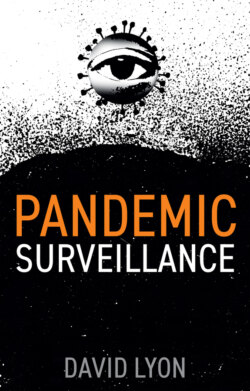Читать книгу Pandemic Surveillance - David Lyon - Страница 7
1 Defining Moments
ОглавлениеIt all happened very quickly. After some mildly worrying small-print news in January 2020, about a new virus in a Wuhan sea-food market in China, by February, news that the “novel coronavirus” was spreading quickly around the world became headlines. There was the predictable scramble to stock up on toilet paper, and less predictable advice to sanitize groceries. In March, a steel fence was erected round the climbing frame and swing sets in our local park, making it look like a crime scene, and masks started to appear on the faces of passers-by in the street. Not long afterwards, smartphones were sought for pandemic service and I also found myself being called up for conversations about the use of personal data for public health platforms, so that the pandemic’s path could be followed, and future developments modeled and predicted.
In the same month, news media started commenting on the sudden burgeoning of surveillance. Its main feature at that time was the rollout of the first digital contact tracing systems, using smartphones to identify contacts who may have been exposed to the virus. By April, tech giants Google and Apple had joined forces to support Bluetooth-based apps, a signal that platforms and governments were collaborating in such surveillance. Cautions about “false positives” and the need for accompanying testing and treatment facilities, plus fears regarding privacy intrusion, discrimination and marginalization were downplayed by those confident in the capacities of the silver bullet.
Surveillance was also sought for documenting where people are, where they’d been and their health status; data-modeling to track the spread of COVID-19; as well as identifying people who, potentially, had been exposed to infected others. Warnings were issued that there may well be civil liberties consequences as everyday technologies used for commerce, communication and convenience were marshaled for keeping close tabs on everyone, in the name of controlling the contagion. What is built for today may be normalized, worried some, such that they would persist after the virus is contained.
Now, the idea of using surveillance to get to grips with an outbreak of disease has a long history. Some salute John Snow, a London doctor who tried to discover the cause of the 1854 cholera epidemic, as a pioneer data scientist. At that time, a ‘miasma’ theory reigned, suggesting that bad air was to blame. A few years before, Snow had a new hypothesis that the “blue death” could be caused by cesspools, lack of sanitation and contaminated water in poor neighborhoods.
Scorned at the time, when the cholera came, Snow knocked on doors, inquiring about the source of each family’s drinking water. The collected data pointed to a specific pump on Broad Street, Soho. This was confirmed by Reverend Henry Whitehead, initially skeptical of the polluted water idea, who checked further to see who had and had not used that pump. The pair removed the handle, effectively shutting off the water supply, and the cholera cases quickly dwindled.1 The conviction that such data collection from infected people could aid the task of getting a grip on the germ is basic to epidemiology, a key discipline in public health.
